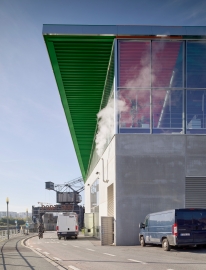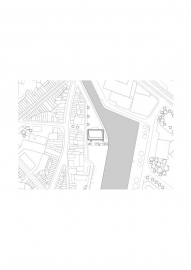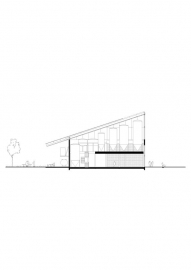Brussels Beer Project
Brussels Beer Project
The new brewery for Brussels Beer Project (BBP) is located along the Brussels canal within the rapidly redeveloping industrial zone of Port Sud. The building houses the complete beer production process, but is also open to the public. It is conceived as a compact and efficient industrial container, a rectangular box with an inclined roof that reveals its content and expresses the company’s graphic identity, in the form of stripes in the characteristic colours of BBP beer labels.
The winning proposal the competition for a new brewery for Brussels Beer Project takes the opportunity of its location at the brim of the Brussels canal to the maximum.
It communicates its strong character and ambition: a building dedicated to the production of 35 000 hl of beer per year, that willingly invites the public to witness and sample its
products. The project follows the concept of a ‘boîte magique’: a super efficient and compact industrial container, topped with a large inclined roof, which is coated in the characteristic colour duos of the BBP beers and communicates its content to all sides. Inside, a series of table-like platforms connected with stairs, support an unusual but highly compact multi-level arrangement of the brewing machinery and vats, which as large pieces of furniture populate the space and are visible through the large greenhouse façade. The public taproom, situated just under the roof and accessible through a public entrance on the canal side, overlooks the brewing hall and can be opened to transform into a terrace. In summer, the adjoining terrain will function as a ‘beer garden’, housing an open-air bar and small events.
The section of varying height accommodates a highly compact multi-level arrangement of the brewing machinery and vats in a series of table-like platforms connected with stairs. Akin to large pieces of furniture, these elements populate the space and are visible through the large greenhouse facade. The open plan enables a flexible organisation that can be altered as the technological requirements evolve.

 © Bas Princen
© Bas Princen
 © Bas Princen
© Bas Princen
 © Bas Princen
© Bas Princen
 © Bas Princen
© Bas Princen



